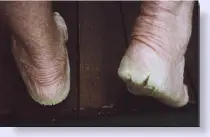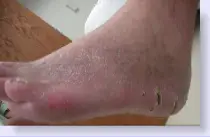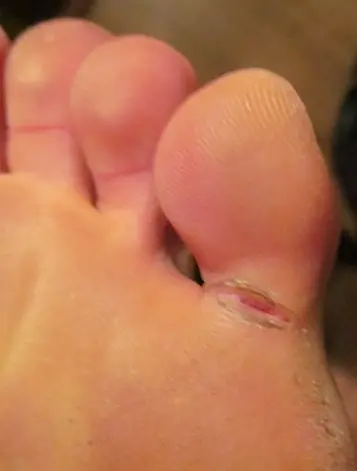heel fissure (cracked heels)
AUTHOR: Marc Mitnick DPM home --> heel fissureWHAT IS A HEEL FISSURE
Cracked heels also known as heel fissures or skin fissures are cracks that occur in the back of the heel, usually on both heels. For some people this can be a chronic problem, which is more annoying than dangerous. However, for some people such as diabetics, people with poor circulation and people with immunosuppressant diseases this problem can have major consequences. At times, the cracks can be very painful.
Skin fissures can occur in most parts of the body, but they are most common on the feet and the hands, primarily, the fingers.
WHAT CAUSES A PAINFUL HEEL FISSURE
The following will cause fissures on heels to dry out and eventually crack:
- dry skin known as xerosis
- disruption in the barrier or protective function of the skin, leading to increased water loss from the epidermis (outer skin layer)
- low humidity as seen during the winter
- genetics- some people are prone to dry skin
- diuretics- water pills eliminate water from the body and can dry out the skin
- decreased sweat gland activity
- dyskeratosis- abnormal formation of keratin layer
- medical conditions- including venous stasis, eczema, diabetes, hypothyroidism, Down syndrome, kidney disease, lymphoma and malnutrition
- backless shoes- Over the years I have seen this condition to be more prevalent in heavier people and those that wear backless shoes. Regular shoes that have a back to them keep the heel ‘cupped’, in other words the skin and fat of the heel area is pushed together. When you wear a backless shoe all the body fat and skin is displaced laterally and it tends to become callused and since callused skin is not healthy skin, it will begin to crack and the heel fissure will form.
- obesity-obviously, the heavier you are the more the heel fat and skin is displaced laterally even if you wear shoes with a back to them. This puts pressure on the skin to break open.
Below to the left is a picture of a severe case of heel fissures secondary to excessively dry callused skin. To the right is simple heel fissuring.

|

|
So what is the big deal about cracked heel fissures?
Many people find it to be cosmetically unacceptable, particularly women who wear very dressy shoes. Some people find the heel fissures to be painful. Initially as the skin begins to split there is not too much pain, but as the fissure deepens (and lengthens) it eventually affects healthy skin and will begin to hurt. It is like any other cut you may have on your body with the exception that you are walking on it. (ouch!)
The plot further thickens because these heel fissures are very prone to becoming infected. Once they become infected they become even more tender, they start draining and the surrounding area becomes red. (cellulitis). It does not take a great leap of faith to see how easily this can occur. The foot is usually subject to dirtier surrounding environments than the rest of the body and bacteria can easily invade these fissures.
In an otherwise healthy individual this problem can be easily remedied. But as stated earlier, in a diabetic or someone with poor circulation to the feet or someone suffering from any disease state, which increases their susceptibility to infection, this minor problem becomes a major problem. Why, because in those situations the body is not able to heal the infection and that can have gross consequences.
SKIN FISSURES
Skin fissures may also be seen on other parts of the feet. Typically skin fissures on the foot will appear in areas of dry skin, deeply callused skin and areas of skin infections such as athletes foot and eczema. The most common locations for skin fissures on the feet include a callused bunion joint, calluses on the bottom of the big toe and calluses or skin infections at the ends of the toes.
A bleeding skin fissure, many times, is the first indicator to a patient that they have something "wrong" with their foot.
A condition a lot of podiatrists see is a skin fissure underneath one of the toes, where the toe meets the foot. Typically, it will be seen mainly under the fifth toe, but on occasion it may also appear under the fourth toe.

|
This type of skin fissure is usually the result of athletes foot on the crease of the toe. Typically, a patient will present complaining of severe pain under the toe for no apparent reason; it will hurt more as they walk, primarily because as the toe bends up during gait, the motion "stretches" the skin fissure and it begins to hurt.
In these instances, not only do we have to clear up any athletes foot, but we have to hydrate the skin fissure so that it will close and more importantly not develop a secondary bacterial infection. Typically, I will have the patient use Bacitracin twice a day, rubbing it well into the skin fissure and insist they wear a more rigid shoe so that the toe is not forced to bend upwards. The condition will usually dramatically improve within a few days.
TREATMENT FOR HEEL FISSURES
heel fissure remedies
Athletes foot What many people, who have chronic dry heels with or without fissuring, do not know is the fact that it is being caused by athletes foot. The dry scaliness of athletes foot will promote skin fissures.
Ever wonder why you are putting a ton of dry skin lotion on your feet and the heels never clear up? That is one reason. For that reason I generally recommend an emollient and an antifungal cream mixed together and applied twice a day usually for 3-4 weeks. For more resistant cases I might even use an oral antifungal agent. The important thing to remember is that you can usually control athletes foot, but it can be very hard to cure.
Another scenario that I see is people who wear work boots all day long with their feet perspiring. Generally, these people will throw the boots into the closet, only to wear them the following day. If athletes foot is part of the problem causing fissuring then it is important that the boots be allowed to "air" out at night either by being placed by an open window, or on the back porch, etc. in order for air to get inside the boots.
Open back shoes As mentioned earlier if you are going to insist on wearing open back shoes you can pretty much rest assured that you will never improve on this problem. Cold weather further worsens the problem because the colder the weather, the less humidity in the air, and the more the skin dries out in general. In many instances, avoiding open back shoes and only wearing closed shoes does not remedy the problem because the fat under the heel still expands too much laterally even in the closed shoes. The best way to help keep the fat under the heel and allow the skin to mend is through the use of a plastic heel cup. (scroll to the bottom of the page to see the heel cup I recommend)
Manual removal of heel callus If your heels look anything remotely like the picture above it is mandatory that the callus be removed otherwise the fissures will never resolve.
A foot specialist should be called upon to debride the callus. You should never attempt ‘bathroom’ surgery as in most cases you will not come close to removing the necessary dead tissue and you will probably make matters worse.
Keratolytic agent If the callus is so severe that even debriding the growth cannot rid the foot of the callus, I usually will recommend a keratolytic agent, or a cracked heel cream, for the patient to apply at bed time and then cover the heel with plastic bags covered with loose socks in an effort to moisturize the area to allow for better penetration of the medication. A keratolytic agent actually helps "dissolve" the hard skin. My favorite type of cream is one that contains urea as it will "dissolve" the very hard dry skin. There is over the counter products containing urea, but prescription urea is of a stronger concentration.
Some people have very sensitive skin and unfortunately most creams and emollients are made from petroleum by products and have many synthetic ingredients added to them to change the smell or consistency of the cream. For those of you in that category, one option is to try all natural shea butter. This compound has been around for centuries and is very effective.
By reducing the size of the callused tissue you are also reducing the depth of the fissure and that will make them feel better and easier to close. Some doctors even go so far as to recommend Crazy glue to glue the fissure shut in an effort to reduce pain. I am not a big fan of that because if the fissure happens to be infected, even mildly, you will essentially be gluing the infection into the skin and it will worsen dramatically.
Infected heel fissures If the fissures are infected that has to be addressed as well. For mild infections topical ointments like bacitracin ointment applied twice a day with a dressing is helpful. I recommend you take a q-tip and ‘work’ the medication into the fissure itself because since bacitracin is an ointment it will also help to soften the area.
Oral antibiotics For more severe infections or in people at risk, sometimes oral antibiotics are necessary. Keep in mind that soaking your feet in Epsom salt or boric acid will only make matters worse since salts tend to dry out skin.
The other point to come away with here is that in most cases these are chronic conditions. Using the advice given above you can dramatically improve on them, but you will always have to be cognizant of the problem and deal with it on some type of regular basis.
REFERENCES
Want more information? CLICK HERE


Recent Articles
-
Vitamin D impact on health
Feb 06, 23 07:17 PM
Researchers are suggesting that the effectiveness of Vitamin D in fighting and preventing disease is predicated on a persons body mass index (BMI). The thinner the person the greater the positive impa… -
Foods to speed up healing
Feb 01, 23 02:41 PM
One of the best ways to help yourself heal faster after surgery is to eat well. Getting the proper nutrition will provide your body with the essentials it needs to promote healing. Here is a suggestio… -
Cancer and Type 2 Diabetes
Jan 25, 23 04:52 PM
An article revealing that older type 2 diabetics have a higher incidence of cancer then non-diabetics. It is suggested that cancer may surpass CVD as the number one cause of death in older diabetics. -
Does glucosamine or MSM reduce arthritis pain?
Jan 22, 23 01:41 PM
A good review of the possible benefits to taking glucosamine, chondroitin or MSM for arthritis. Always beware of the possible side effects of over the counter supplements. -
shin splints
Jan 18, 23 05:12 PM
A great review on the various causes of shin splints, along with treatment options. -
Whats new in skin cancer?
Jan 15, 23 08:32 PM
A presentation of newer skin protection combinations in an effort to better protect the skin from the hazards of sun exposure. -
Causes and risk factors of warts
Jan 14, 23 05:02 PM
A good review of the causes of warts and protective measures you can take to prevent developing them. -
Do chronic wounds need to be dressed daily?
Jan 11, 23 02:18 PM
Because of supply chain shortages as well as staffing shortages particularly during the pandemic, many institutions extended the time between dressing changes for chronic wounds. Is this really the be… -
Food choices that raise your risk of type 2 diabetes
Jan 08, 23 10:07 AM
A good review of how blood sugars can become elevated and the harm that can do. Certain food groups have a tendency to raise your blood sugars and should be avoided. -
Outcome stats from Scarf bunionectomy
Jan 03, 23 03:04 PM
The Journal of Foot and Ankle Surgery recently reported a meta analysis of outcomes in 1583 Scarf bunionectomies that met their inclusion criteria. Adverse events did not seem to be any better or wors…